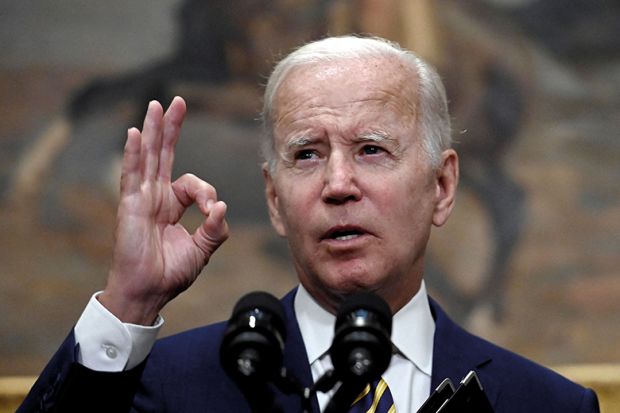President Joe Biden granted more than $300 billion (£250 billion) in student debt relief to more than 43 million borrowers, largely meeting a 2020 campaign promise, in a move given a cautious welcome by US higher education as a short-term solution.
The centrepiece of the plan provides between $10,000 and $20,000 per person in student debt forgiveness, limited to borrowers now earning less than $125,000 a year. Mr Biden also announced a substantially more generous income-driven repayment proposal, and an end to the government’s Covid-era payment suspension.
“These targeted actions are for families who need it the most,” Mr Biden said.
US higher education largely welcomed the move as one of the few realistic short-term student aid options available to the president without the approval of Congress, while pointing out the urgent need for more fundamental changes – including by the academy itself – to make college more affordable over the long term.
“It is extremely important that colleges and universities also do their part,” the American Council on Education (ACE), the umbrella group of US higher education, said in a response attributed to its president, Ted Mitchell. “Institutions must provide an education of value in all of their programmes and to all of their students.”
Within political circles, Mr Biden’s more progressive allies largely shifted from months of demanding that he offer a greater amount of debt forgiveness to praising his resolve. Opposition Republicans, meanwhile, jumped at the chance to accuse the president of ignoring students who dutifully repaid their loans and low-income Americans who never even went to college.
Democrats, however, expressed confidence that voters understood the burden of college loan debt. Student loan debt has quadrupled in the past 12 years, with more than 45 million borrowers owing more than $1.6 trillion in total, making it the nation’s second-largest form of household debt, behind only housing.
Mr Biden, recognising the importance of a needs-based component of his plan, included the $125,000 annual income limit, and doubled his promised $10,000 forgiveness level to $20,000 only for those borrowers who had been eligible for the Pell Grant, the main federal subsidy for low-income students.
The result, the administration said, is that 43 million borrowers will receive some benefit, 20 million will have their student debt completely wiped out, 90 per cent of the aid will reach those now earning less than $75,000 a year, and none of the aid will go to people in the top 5 per cent of income nationwide.
The president’s move is seen by experts as raising pressure on higher education to fulfil its promises to make their operations ever more efficient, transparent and beneficial to students. Dr Mitchell said the ACE’s goals included making pricing structures clearer to students and being more open to transferring credits between institutions.
The administration’s action leaves many tough problems still to solve, said one expert, Brian Powell, a professor of sociology at Indiana University. The good news, though, is that US voters back student loan forgiveness and are even more supportive of making public universities tuition fee-free, Professor Powell said.
“As a short-term solution, some loan forgiveness absolutely makes sense,” said Professor Powell, an author of Who Should Pay?, a book published this year aimed at identifying the parties that should cover the cost of higher education. “But this is just a short-term solution.”
后记
Print headline: Biden’s approval of $300bn in US student debt relief to help millions




